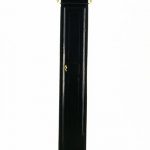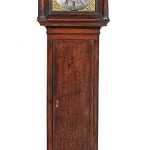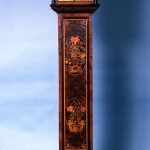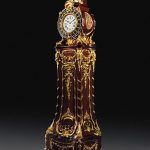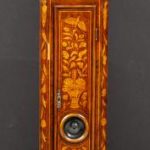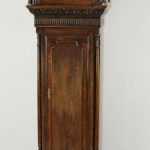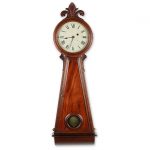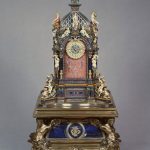Longcase Clocks. A longcase clock, also tall-case clock, floor clock, or grandfather clock, is a tall, freestanding, weight-driven pendulum clock with the pendulum held inside the tower, or waist of the case. Clocks of this style are commonly 1.8–2.4 meters (6–8 feet) tall. The case often features elaborately carved ornamentation on the hood, or bonnet, which surrounds and frames the dial, or clock face. The English clockmaker William Clement is credited with the development of this form in 1670. Most longcase clocks are striking clocks, which means they sound the time on each hour or fraction of an hour.
The terms “grandfather”, “grandmother”, and “granddaughter” have all been applied to longcase clocks. Although there is no specifically defined difference among these terms, the general perception seems to be that a clock smaller than 1.5 m (5 ft) is a granddaughter; over 1.5 m (5 ft) is a grandmother; and over 1.8 m (6 ft) is a grandfather. Reference: The Full Wiki
This clock is housed in a long case veneered with ebony on oak. The lift-up hood is glazed on three sides. At the corners it has attached Corinthian columns with gilt-bronze bases and capitals. They support a pediment with a gilt-bronze cartouche and laurel swags. The acorn finials beneath the front columns on the hood suggest that the clock was originally designed to be hung on a wall, but was later adapted as a long-case clock. The present pendulum is only 7 inches long. One key. Two weights: lead with brass case, each marked 5.2kg (diameter: 7cm, height excl. ring: 13.5cm) Condition: the cartouche described as a modern replica on file note.
ca. 1660 (made). Fromanteel, Ahasuerus, born 1607 – died 1693 (maker)
Reference: © Victoria and Albert Museum
A George II/III thirty-hour oak longcase clock, circa 1760 Thomas Cox, Cromhall, Gloucestershire The square hood with brass ball-finial surmounted pagoda top and blind-fret cornice, the trunk with line-inlaid door, on a rectangular base with cut-away plinth, the eleven-inch square signed brass dial with Roman and Arabic silver chapter ring and matted centre, the movement with anchor escapement and outside countwheel strike, 228cm high
Sold for £ 701 inc. premium at Bonham’s in 2019
WEIGHT-DRIVEN EIGHT-DAY LONGCASE NIGHT CLOCK IN A WALNUT AND FLORAL MARQUETRY CASE. : Eight-day night clock; weight-driven movement with four wheels in the train; anchor escapement and seconds pendulum; time can be seen at night or in poor light by lamp shining through the pierced numerals and minute marks; lamp sits on shelf behind movement; succession of pierced Arabic hour numerals pass behind a pierced lunette which is cut in the upper section of the dial; these numerals pass pierced minute marks on upper edge of lunette, thus indicating the minutes; quarters are shown by pierced Roman numerals I, II and III; setting square is at centre and winding square at bottom of dial. TRAIN-COUNT. Gt wheel 120 2nd wheel 80/10 3rd wheel 72/8 Escape wheel 30/6
Made by: Edward East
Reference: © The Trustees of the British Museum
A FRENCH ORMOLU-MOUNTED MAHOGANY LONGCASE CLOCK BY MAISON MILLET, PARIS, LAST QUARTER 19TH CENTURY The drum-shaped upper section surmounted by serpent and scythe encircling a sphere and oak branch, with a scallop shell and foliate-cast encircling a white enamel dial signed ‘Millet/ AParis’, the sides each with a grille of pierced foliate design, the waisted middle section headed by a foliate-cast scrolled bracket to each corner, supporting a foliate festoon above a ribbon-tied floral musical trophy within a foliate-cast fluted surround, on rectangular base with panelled sides hung with foliate swags on scroll feet 110 in. (279.5 cm.) high; 33 in. (84 cm.) wide; 24 ¼ in. (61.5 cm.) deep
Sold for GBP 81,250 at Christie’s in 2019
Dutch Rococo Style Fruitwood and Walnut Marquetry Longcase Clock The arched hood with foliate-carved cresting, engaged columns and glazed door, the case door with lenticle, the base with canted corners, the associated English movement with brass dial brass face, foliate spandrels and signed Quinton/Downton, the two-train five pillar movement with anchor escapement. 83 inches (210.9 cm).
Sold for $937 (includes buyer’s premium) at Doyle in 2019
18th century Wilkes & Sons Irish oak tall case clock with brass face decorated with dragons and masks. 98 1/2″h x 24″w x 10 1/4″d
Sold for $1,100 at King Galleries in 2020
